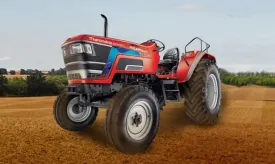Tractor HP Guide: Best Horsepower for Small, Medium & Large Farms

Choosing the right tractor HP (horsepower) is one of the most important decisions a farmer makes when buying a tractor. A tractor is more than just a machine – it is the heart of modern farming operations. Whether it's ploughing, sowing, harvesting, or transporting, the right tractor horsepower ensures efficiency, saves fuel, and helps farmers get the most out of their investment.
In this tractor buying guide, we'll break down the ideal tractor power selection for small, medium, and large farms, so you can match the horsepower to your farming needs.
Understanding Tractor Horsepower

Horsepower (HP) in tractors refers to the engine's power output. It determines how well a tractor can pull implements, operate attachments, and perform farming tasks under different soil and crop conditions.
- PTO HP (Power Take-Off): Power available for operating implements like rotavators, seed drills, or sprayers.
- Drawbar HP: Power used for pulling loads, trailers, and heavy implements.
When choosing a tractor, farmers must consider farm size, soil type, crop requirements and implements before finalizing the HP range.
Best Tractor HP for Small Farms (1–5 acres)

Small farms usually focus on vegetable farming, orchards, or cash crops. They require compact, fuel-efficient tractors with enough power to handle light to moderate tasks.
- Recommended Tractor HP: 15–35 HP
- Suitable Tasks:
- Soil preparation using a small cultivator or rotavator
- Sowing and inter-cultivation
- Orchard operations and spraying
- Light transport within the farm
Why This Range Works:
Compact tractors in this HP range are cost-effective, easy to maneuver in small fields, and compatible with small farm implements. They also consume less fuel, making them ideal for marginal and small-scale farmers.
Examples: Mahindra Jivo series and other mini tractors.
Also Read: Mahindra Tractors: Best Tractors for Farming | Models & Prices
Best Tractor HP for Medium Farms (5–15 acres)

Medium farms require versatile tractors that can handle both primary and secondary tillage, crop cultivation, and medium-scale transport. Here, a balance between power and fuel efficiency is key.
- Recommended Tractor HP: 36–50 HP
- Suitable Tasks:
- Primary tillage with a disc plough or MB plough
- Sowing with seed drills or planters
- Spraying and intercultural activities
- Hauling trailers with produce or inputs
- Harvesting with smaller tractor attachments
Why This Range Works:
This HP range provides enough power to use medium-sized tractor implements like rotavators, cultivators, seed drills, and sprayers. Farmers with multiple crops benefit from the tractor's versatility without spending heavily on larger, fuel-hungry machines.
Examples: Mahindra OJA, SP, XP series tractors
Best Tractor HP for Large Farms (Above 15 acres)

Large farms demand powerful tractors that can operate heavy-duty equipment and cover wide areas quickly. For crops like sugarcane, wheat, cotton, and paddy, higher HP ensures timely cultivation and harvesting.
- Recommended Tractor HP: 50–75+ HP
- Suitable Tasks:
- Heavy tillage with disc harrows and subsoilers
- Operating large rotavators and multi-crop planters
- Mechanized harvesting with tractor attachments
- Hauling heavy loads and multi-axle trailers
- Using advanced implements like balers and sprayers
Why This Range Works:
High-HP tractors provide the strength to manage multiple crops and large workloads. They are also compatible with advanced tractor implements designed for commercial farming and long working hours.
Examples: Mahindra Arjun Novo etc
Key Factors in Tractor Power Selection

While farm size is the first step, other factors also matter in selecting the best tractor horsepower:
1. Soil Type & Terrain
- Light soil: Lower HP is sufficient.
- Heavy clay soil: Higher HP required for deep tillage.
- Hilly terrain: Mid to high HP tractors provide better pulling strength.
2. Crops Grown
- Vegetables & orchards: Compact tractors with 15–35 HP.
- Cereals & pulses: Medium tractors with 36–50 HP.
- Commercial crops (sugarcane, cotton): Large tractors with 50+ HP.
3. Implements Used
- Rotavators, cultivators, and seed drills can work with 25–40 HP tractors.
- Heavy ploughs, harvesters, and balers need 50+ HP tractors.
4. Budget & Fuel Efficiency
- Lower HP = lower price and fuel consumption.
- Higher HP = higher productivity but increased cost.
5. Future Expansion
If you plan to expand your farm or add more implements, investing in a slightly higher HP tractor may be wise.Tractor Buying Guide: Matching HP with Farm Needs

- Small farms (1–5 acres): Go for 15–35 HP compact tractors for cost efficiency and ease of use.
- Medium farms (5–15 acres): Choose 36–50 HP tractors for versatility across crops and implements.
- Large farms (15+ acres): Invest in 50–75+ HP tractors for maximum power, efficiency, and heavy-duty farming.
Role of Tractors in Modern Farming

Today's tractors are not just about raw horsepower; they come with features like fuel-efficient engines, smart transmission, and compatibility with modern implements. The right tractor HP ensures:
- Reduced fuel costs
- Faster operations
- Longer tractor life
- Better crop productivity
By making the right tractor power selection, farmers can achieve higher efficiency and profitability while reducing overall labor.
Final Thoughts

Selecting the correct tractor horsepower is crucial for farm productivity and profitability. While small farms benefit from compact, fuel-saving tractors, medium and large farms need more power for multiple implements and heavy-duty work. By considering farm size, soil type, crops, and budget, farmers can choose the best tractor for their needs.
In the end, the right tractor isn't about buying the most powerful machine but about finding the horsepower that perfectly matches your farming operations.
















